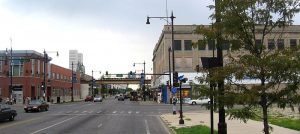 Chicago has struggled to get rid of its reputation as the murder capital of the world. Some would argue that Johannesburg in South Africa and some cities in Middle East would give Chicago a run for its money. However the reality is that there are far too many homicides in the state. It is almost always a narrative of poor choices, deprived backgrounds, and a criminal justice system that is hard-pressed to cope with the epidemic. Malik Causey is a case in point. Starting with petty theft and teenage rebellion; he ended up in a gang and was soon shot by a rival. His mother Monique Causey describes how she desperately wanted the police to arrest her son in order to keep him off the streets, and by extension the gangs that he had admired so much in his teenage years and then proceeded to join with disastrous consequences.
Chicago has struggled to get rid of its reputation as the murder capital of the world. Some would argue that Johannesburg in South Africa and some cities in Middle East would give Chicago a run for its money. However the reality is that there are far too many homicides in the state. It is almost always a narrative of poor choices, deprived backgrounds, and a criminal justice system that is hard-pressed to cope with the epidemic. Malik Causey is a case in point. Starting with petty theft and teenage rebellion; he ended up in a gang and was soon shot by a rival. His mother Monique Causey describes how she desperately wanted the police to arrest her son in order to keep him off the streets, and by extension the gangs that he had admired so much in his teenage years and then proceeded to join with disastrous consequences.
Although touching in its own right, this case is just one of the 91 homicides that were committed during August of 2016 within Chicago. This has been described as the deadliest month within the city for nearly 20 years. The current annual increase in homicides stands at 46% by some estimates. Chicago is way past the magic number of 500 homicides per year. For context, it is worth noting that the total killings in the city outweigh the combined total of New York and Los Angeles (no safe havens themselves if the crime statistics from there are to be believed). The more dramatic analysts have described this as a kind of massacre on American streets.
Finding the Root Causes of the Violence
Many people believe they know what is behind the gory killing fest in Chicago. They point to the impoverished neighborhoods that everyone seems to have forgotten about even as the metropolis experiences unprecedented regeneration. In the absence of any economic activity, young men have congregated into street gangs that originally began as some sort of camaraderie before descending into protection rackets and finally culminating into predatory criminal enterprises that terrorize the city. The principal victims of the violence are young African American men. Behind the horror statistic of August 2016 are 71 African Americans and 11 Hispanic young men; 50% of whom had not reached their 25th birthday before being killed.
The police have responded by developing a legally dubious Strategic Subject List; a code name for profiling. The law enforcement agencies justify their actions by showing that that 70% of those that were killed in that fateful August were on the SSL list. Currently the list has up to 1400 people who are admitted on the basis that they are likely to be targets of gang violence. The risk factors include gang membership and a criminal past or present. In the end the gangs play a game of Russian roulette which is punctuated by a tit-for-tat series of revenge attacks that show no sign of dissipating any time in the foreseeable future. The rest of the citizenry in Chicago are either witnesses or collateral damage.
Community Responses
There is a real danger of decent people fleeing Chicago for no other reason than the fact that they can no longer stand the violence. The Englewood neighborhood is particularly at risk. More than 40% of Englewood residents are living below the poverty line and its homicide rate increased by 171% between 2015 and 2016. The area has appeared on the dreaded notorious four police districts that account for 30% of all the murders committed in August 2016. If you are looking for an experienced lawyer to help you with your reckless homicide case, call David Freidberg Attorney at Law at 312-560-7100 today.
(image courtesy of MrHarman)
 Chicago Criminal Lawyer Blog
Chicago Criminal Lawyer Blog


